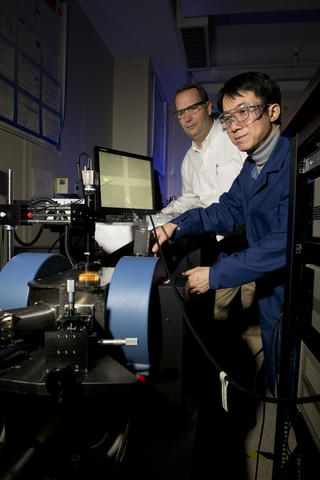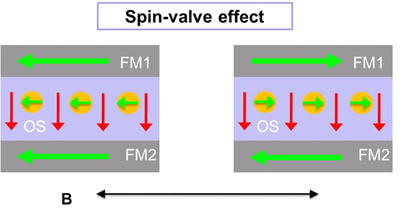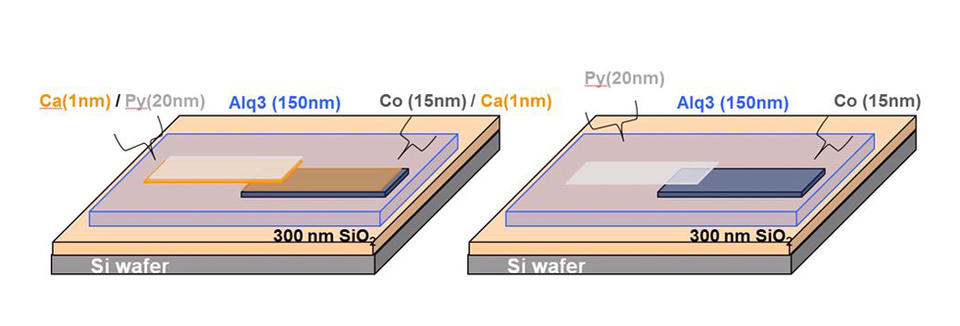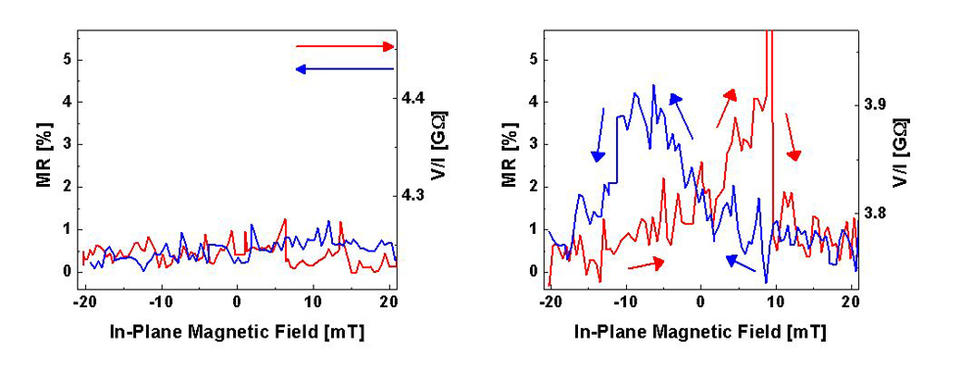
Richter (left) and Jang (right) measuring the spin-valve effect of a device.
Researchers in the Semiconductor and Dimensional Metrology Division's Nanoelectronic Device Metrology (NEDM) Project have demonstrated the first documented case of electron spin transport in an organic device.1
The work has important implications for the burgeoning field of "spintronics," which encodes and processes information in the quantum-mechanical spin of particles such as electrons and holes, rather than in the form of electrical charge, as in conventional silicon-based transistors. "Spintronics is interesting because it might be a pathway to make lower-powered computation devices," explains Curt Richter, leader of the NEDM Project. "It's lower-powered because it uses the intrinsic spin of the charge carrier, which requires far less energy to manipulate than moving the charge carrier around."
"What's limiting the speed of our computers today," Richter continues, "is not how fast we can move the charge in silicon, but the power it takes to move the charge. If we could use spin to make a lower-powered structure, computers could go faster."
So, why use organic devices when spintronic technology in metals already has commercial applications in devices such as computer hard drives? "In most materials, the spins of transported particles passing through the material get randomized very quickly," Richter explains. This severely limits their utility. "But organics are expected to permit a long spin lifetime, allowing you to maintain the spin's state for long enough to do something useful."
NEDM Project colleague Hyuk-Jae Jang, elaborates: "You need to maintain the spin to carry out logic operations. So, the longer the better. If it's too short, you'll lose the information before you complete the operation."
Along with a long spin lifetime, organic materials are also "light, flexible, and you can mass-produce the product with lower cost than current non-organic semiconductor-based devices," Jang says.
In much recent research, spin transport is detected by the spin-valve effect. A tiny voltage is applied across a microscopic device which consists of an organic semiconductor material sandwiched between two ferromagnetic layers, each of which has a slightly different response to applied magnetic fields. If an applied magnetic field is swept across the device, the polarization of each layer switches at different times. These changes alternatively create parallel and anti-parallel configurations which result in high or low electrical resistance to spin-polarized particles traveling across the device. The relative magnetic alignment of the ferromagnetic layers thus becomes a sort of valve that controls particle transport. See the figure below for an illustration.

"We would like to help figure out how to harness spin for useful technology applications," he explains. "The organic materials, from a theoretical standpoint, should be ideal for carrying the spin, but the experiments to date aren't really showing that. And because there is some skepticism about the most positive results, we wanted to try to clarify the research."
Using Alq3 (tris-(8-hydroxyquinoline) aluminum) as the organic semiconducting material between two ferromagnetic layers, Richter's team created two different sets of samples simultaneously; one set with a thin layer of Ca, a low work function metal, between the ferromagnetic layers and the Alq3, and the other without the Ca. Richter's team believed that the layer of Ca would completely align the Fermi energy of the spin injector and detector with the conduction band of the Alq3, promoting electron spin transport across the layers.

"You don't want [the Alq3 layer] so thin that the electrons might be tunneling through the material," Richter explains. "You also don't want it so thick that the spins will completely dephase before they get across."
In testing the devices, Richter's team was able to see the spin-valve effect in the set of devices containing Ca – the first time electron spin transport had been observed in an organic device. In the devices without Ca, no spin-valve effect was detected at all.

The next step for Richter's team will be to build on these results using a purer organic material. They intend to grow crystals of the organic materials to use in devices with the goal to use a single-crystal organic semiconductor to demonstrate spin transport.
1Jang et al., Applied Physics Letters 101 (2012)
2 Xiong et al., Nature 427 821 (2004)
Written and photographed by Erik Secula

